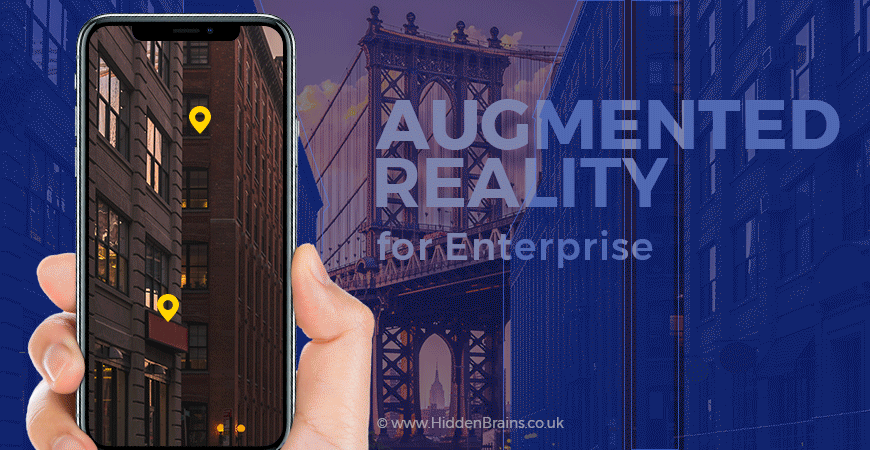
According to new research from the Consumer Technology Association (CTA), Augmented reality (AR) and virtual reality (VR) technologies are set to take centre stage. Both technologies will witness revenues of $1.2 billion. The U.S. Consumer Technology Sales and Forecasts report from CTA projects, AR/VR headsets and eyewear will sell 4.9 million units in the in 2018, a more than 25 percent increase from 2017.
With limitless potential and better future of Augmented Reality app development is helping organizations gain unique edge in many different processes, right from manufacturing, assembly, and construction to real estate and education. AR’s combines real-world images with online data to change the way work is done across diverse industries. Top emerging technologies for business such as Internet of Things and artificial intelligence combined with Augmented reality ignited the imagination of manufacturers, entrepreneurs, and investors.
The advancement of Apple’s ARKit and Google’s ARCore development platforms in iOS development and Android development has literally put AR-powered mobile devices in almost everybody’s hands.
Related Post: How Does Augmented Reality Technology Work
The Future of Augmented Reality App Development in Enterprise
Enterprise AR for seamless service delivery
Augmented reality is now coming across as a key differentiator for quick service delivery as well as quality services in each and every phase of supply chain. Use cases are emerging across the product lifecycle that are impacting large, consumer packaged goods companies for manufacturers and service organizations. Augmented reality will be adopted across multiple businesses as a coherent part of digital transformation strategy. Large enterprises are now moving out from the experimental phase towards actually implementing and deploying AR app for greater ROI.
The increase in growth signifies service monetization becoming a huge driver for growth trying to differentiate in the field service market with first-time quality — the better.
AR for accessibility for enterprises
According to IDC, enhancements in development tools will increase the number of non-tech developers, and by 2021, these non-traditional tech developers will build almost 20% of business applications and 30% new application features (60% by 2027). As a result, the entry to AR development will accelerate broader adoption.
For large enterprise, it’s typically process or manufacturing engineers — creating workflows. Augmented reality application development tools are allowing people who are not technical to develop custom workflows and translate into AR experiences.
Advances in speech will take vital interaction paradigm
AR-based wearables is turning out to be a highly effective way to communicate with target users. The coming year will see a dramatic increase in demand for developers with the capabilities to build augmented reality app combining Natural Language Processing. Although the reach of voice interaction is still limited by words a user can say at a certain time naturally, it will still be a top interaction paradigm for AR in 2019.
Growth of 3D content for both consumer and enterprise applications
Several technology giants are investing in acquiring VR companies or related tools that will help AR content boom in both consumer and enterprise areas. The development of AR technologies and its proliferation in both iOS and Android devices is blurring the gap between real and the digital world. Augmented reality app development will raise the bar when it comes to engaging with workforce with content-centric, communication focused between people and systems.
With expanded use cases, rapid content creation, advances in speech and new development toolsets, AR will empower workforces to drive real ROI and lead to greater adoption.
AR impacts the enterprises business as well as the future of work.
Successful Case Studies
Maintenance and repair
Toms River Municipal Utilities Authority in New Jersey
Visualization of underground infrastructure facility of utility lines in real time with AR headsets before workers begins the actual process of digging. This accelerates planning and maintenance efforts as well as minimizing errors. With support for hand gestures and voice commands, the interface allows workers to operate effectively hands free as they gather information.
Logistics
DHL, the logistics giant
Touted as “vision picking”, DHL uses AR headsets in warehouses to help with order picking. The AR glass display identifies location numbers, scans product bar codes, identifies the number of items that need to be picked and shows workers where each item should be placed in the trolley.
The technology increased productivity by 15% and dramatically reduced error rates. Around 50% less time spent on training and onboarding.
Recruitment
Jaguar Land Rover and the British band Gorillaz
These two companies worked on a recruitment-related drive that utilizes AR and VR to attract young and aspiring talent. In this entirely new way of recruitment, an Augmented reality app challenge that combines AR and VR, as well as the real world. A virtual garage is brought to life for potential candidates, creating challenges to gauge potential candidate’s skills in several areas such as software architecture, app development and more. Applicants who successfully crack the code get a full-time role at Jaguar.
Finally
Many challenges exist between the technology itself and mainstream adoption over the next two to three years, but AR clearly holds promise in the enterprise.
Table of Contents





